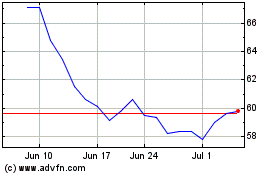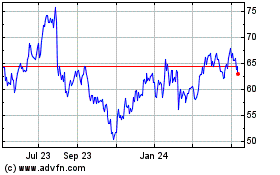By Katie Deighton
Venmo, the payments app owned by PayPal Holdings Inc., has
introduced its first physical credit card, stamped with a prominent
QR code on the front.
Venmo is gradually rolling out the ability to apply for the
card, which is issued by Synchrony Financial, to its app users in
the U.S. starting this week, the company said.
Cardholders can choose from five color schemes -- from
"Nightlife black" to "Cotton Candy pink" -- and must scan the
card's unique QR code with the Venmo app to activate it.
The main purpose of the code on the card is to bring the digital
experience of splitting checks and purchases via Venmo -- a big
part of Venmo's pitch to new users -- into the physical world, said
Darrell Esch, senior vice president and general manager of
Venmo.
"When you're out for dinner and everyone throws their card into
the folio, the waiter has to split the check between four or five
cards," Mr. Esch said. "Whereas here, I can throw my card into the
center, and everybody else can quickly scan my code, link to my
Venmo and push the funds to settle."
That can minimize the amount of touching while out dining, a
potentially appealing feature during the coronavirus pandemic, but
Venmo designed the QR code feature well before Covid-19 upended
life, Mr. Esch said.
The move comes as parent company PayPal pushes touchless
payments in its enterprise division. In a company first, the
financial firm in July said PayPal and Venmo QR code technology
would be installed across more than 8,000 CVS stores, allowing
shoppers to pay for goods by scanning their smartphones at the
register.
PayPal Chief Executive Daniel Schulman said in the same month
that QR code technology would accelerate Venmo's effort to turn a
profit. Still, Venmo has long looked to physical cards as a way to
diversify its revenue stream away from low-stakes digital
transactions among friends. Executives at the firm began meeting
with banks to discuss a credit card in 2018, the same year the
company introduced a debit card -- a simple Mastercard Inc. design
without a QR code print.
While the credit card's code design is a neat addition, Venmo's
attempts to jazz up the in-app experience will be more critical to
the product's success, said Ana Milicevic, co-founder and principal
of digital consulting firm Sparrow Advisers, who wasn't involved
with the project.
"Venmo's not the first entrant targeting mobile-first consumers
and won't be the last, so the user experience here is critical,"
she said. "But if they nail that they stand a good chance to be the
default finance app for many mobile-first consumers."
"Knowing how expensive it is to acquire customers in financial
services, and how Venmo can continue to layer on other services on
top of the card, this bodes well long-term for retention and
customer lifetime value expansion," Ms. Milicevic said.
Venmo offers credit card holders an "intelligent reward system,"
whereby they will earn 3% cash back on purchases made in their top
spending category, 2% cash back on their second highest and 1% back
on all other transactions. Rewards can be earned across eight
categories, and a user's top categories can switch from month to
month.
Other credit card providers are making efforts to adapt their
rewards programs as the pandemic halts spending in categories like
travel. But Venmo's ability to adjust each user's cashback
categories every month is somewhat unique, said Sara Rathner, a
credit card expert at NerdWallet.
"It makes it easier for a customer to become what I call a 'lazy
optimizer': Instead of having to decide which card to use in a
restaurant, or which card to book a plane ticket with, they could
really put everything on the same card," she said. "For somebody
who really just wants one really easy to use card that will reward
them when they shop, this could be it."
A moving pie-chart display in the Venmo app lets users track
which categories will earn them the most cash back, said Dennis
Bauer, senior vice president and general manager at Synchrony,
which issues the credit card.
"It's a fun, lively experience," he said. "The way you watch
your spending trends move up and down from category to category,
and the way in which information is revealed really makes you want
to check the app more frequently."
That attempt to deliver digital dopamine hits, coupled with a
rewards system that encourages spending on categories including
dining-and-nightlife and health-and-beauty, will make it easier for
millennials and Generation Z to spend money during an economic
downturn, said Wendy Johansson, global vice president of experience
at digital agency Publicis Sapient.
"Which is smart, but it's ethically dubious for Venmo to be
offering a credit card to younger generations at this time," Ms.
Johansson said, referencing statistics that showed elevated youth
unemployment this summer. "Venmo should employ their user
experience design expertise for good," building more financial
education into the mobile app so users can better understand the
impact of their spending patterns.
Mr. Bauer said financial education is part of the experience,
citing the ability to view spending patterns by category.
"More transparency gives customers more opportunities to manage
their finances," he said.
Write to Katie Deighton at katie.deighton@wsj.com
(END) Dow Jones Newswires
October 07, 2020 06:14 ET (10:14 GMT)
Copyright (c) 2020 Dow Jones & Company, Inc.
PayPal (NASDAQ:PYPL)
Historical Stock Chart
From Apr 2024 to May 2024

PayPal (NASDAQ:PYPL)
Historical Stock Chart
From May 2023 to May 2024
